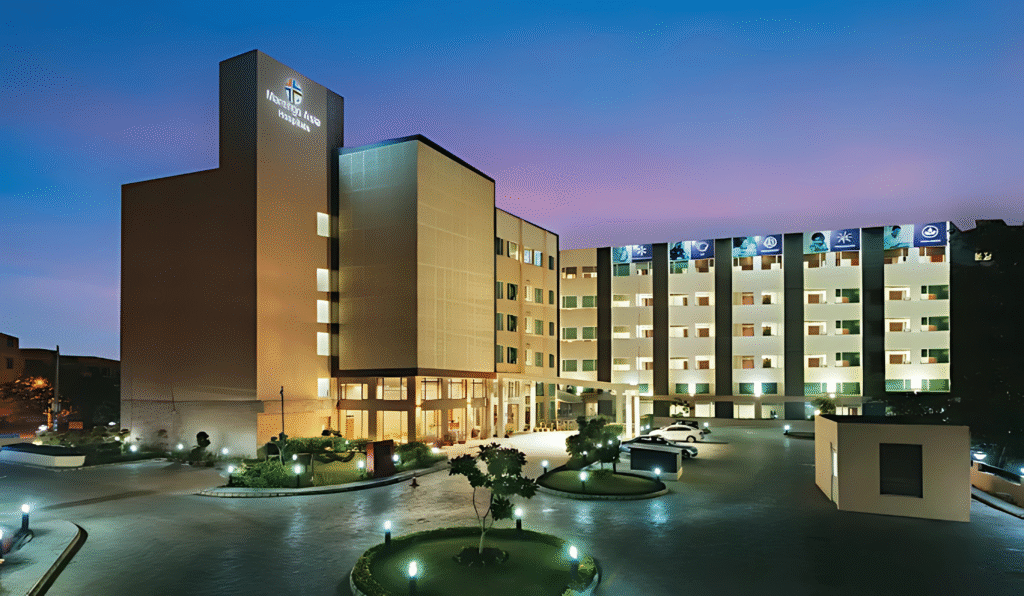Benign Prostatic Hyperplasia Treatment Cost in India

What is Benign Prostatic Hyperplasia?
Benign Prostatic Hyperplasia (BPH) is a non-cancerous enlargement of the prostate gland, commonly seen in aging men. The prostate is a small gland located below the bladder and surrounds the urethra—the tube that carries urine out of the body. As men age, the prostate gradually grows larger, which can squeeze or block the urethra and cause urinary problems.
BPH is not prostate cancer and does not increase the risk of developing prostate cancer. However, it can significantly impact quality of life due to its bothersome urinary symptoms.
How Does Benign Prostatic Hyperplasia Develop?
BPH develops slowly over time and is primarily linked to hormonal changes associated with aging. As testosterone levels drop and estrogen levels increase in older men, it can lead to the overgrowth of prostate cells. This enlargement of the prostate gland begins to put pressure on the urethra, narrowing the urinary passage and making it difficult for urine to pass freely.
This gradual compression of the urethra results in various urinary symptoms like frequent urination, weak urine stream, and difficulty starting or stopping urination. The severity of symptoms varies, but they tend to worsen over time if left untreated.
Causes and Risk Factors of Benign Prostatic Hyperlapsia
While the exact cause of BPH isn’t fully understood, several factors are believed to contribute to its development:
Aging
✔ BPH is rare in men under 40 but becomes increasingly common with age—especially after 50.Hormonal Imbalance
✔ Changes in male hormone levels (like decreased testosterone and relatively higher estrogen) can lead to prostate cell growth.Family History
✔ Men with a family history of prostate issues are more likely to develop BPH.Obesity and Lifestyle
✔ A sedentary lifestyle and poor diet may increase the risk of BPH and worsen symptoms.Chronic Conditions
✔ Diabetes and heart disease have been linked to a higher incidence of BPH.Ethnicity
✔ BPH appears to be more common in certain ethnic groups, particularly in men of African origin.
Symptoms
The symptoms of BPH mainly relate to the lower urinary tract and can range from mild to severe:
Frequent Urination
✔ Especially at night (nocturia), disrupting sleep.Urgent Need to Urinate
✔ Sudden, uncontrollable urge to pass urine.Difficulty Starting Urination
✔ A slow or weak stream, even when there’s a strong urge.Dribbling at the End of Urination
✔ Incomplete emptying of the bladder causes post-urination leakage.Straining While Urinating
✔ Needing effort or pressure to start and maintain urination.Sensation of Incomplete Bladder Emptying
✔ Feeling like you still need to urinate after finishing.
Types of Benign Prostatic Hyperplasia
While BPH itself is a non-cancerous condition, it manifests differently depending on how much the prostate has enlarged and how much it is affecting urinary flow and bladder function. The condition can be categorized in the following ways:
✔ Caused by the physical growth of prostate tissue pressing against the urethra, creating a blockage in urinary flow.
✔ Due to increased muscle tone in the prostate and bladder neck, which tightens and restricts the urinary pathway even if the prostate size is moderate.
- Mild BPH: Occasional symptoms like slightly reduced urine stream or mild frequency. Often doesn’t require medication.
- Moderate BPH: Frequent urination, urgency, and some strain while urinating. Medical treatment is typically needed.
- Severe BPH: Constant urinary difficulty, risk of complete urinary blockage, and impact on kidney and bladder health. Often requires surgical treatment.
- Obstructive Symptoms: Weak stream, hesitancy, dribbling.
- Irritative Symptoms: Urgency, frequency, nocturia (night urination).
Which Type of Benign Prostatic Hyperplasia is the Most Dangerous?
Among the different types, severe static BPH is considered the most dangerous. This form involves significant physical enlargement of the prostate that severely blocks the urethra. If left untreated, it can lead to acute urinary retention, bladder damage, kidney complications, and repeated urinary tract infections. While BPH is not cancerous, advanced cases can significantly affect a patient’s quality of life and overall urinary and kidney health.
Why Choose India for Treatment of Benign Prostatic Hyperplasia
India stands out as a global hub for the treatment of BPH, thanks to a unique blend of medical expertise, affordability, and high-quality care. Here’s why patients from around the world trust India for managing this condition:
India has a large pool of board-certified urologists and andrologists trained at top international institutions. These professionals bring extensive experience in treating complex and recurring cases of BPH using both conventional and advanced approaches.
Indian hospitals, especially in metro cities, offer cutting-edge facilities such as:
Holmium Laser Enucleation of the Prostate (HoLEP)
GreenLight Laser Therapy
Transurethral Resection of the Prostate (TURP)
Robotic-assisted prostate surgeries
These minimally invasive procedures reduce hospital stays, bleeding, and recovery time.
The cost of diagnosis, surgery, post-operative care, and medications in India is often 60–80% lower than in the US, UK, or other developed nations—without compromising the quality of care. This makes India a prime choice for cost-conscious international patients.
From airport pickup to accommodation, language support, dedicated patient coordinators, and follow-up care, top Indian hospitals offer tailored packages for international patients, ensuring a seamless and stress-free experience.
Unlike Western countries, where patients often experience long waiting times for surgery or radiation therapy, India provides quick access to treatment.
Appointments with top specialists can be arranged within days.
Surgery or radiation therapy can be scheduled within a week of diagnosis.
This ensures that international patients receive timely medical attention, which is crucial for cancer treatment.
India is a global leader in medical tourism, offering:
✔ Dedicated international patient coordinators
✔ Medical visa assistance for easy travel
✔ Affordable accommodation & travel support
✔ Multilingual staff, including English-speaking doctors
This ensures a smooth and hassle-free experience for foreign patients traveling to India for treatment.
Different types of Benign Prostatic Hyperplasia Treatment in India
Prostate cancer treatment depends on factors like cancer stage, patient age, overall health, and the aggressiveness of the tumor. There are multiple treatment options available, ranging from active surveillance for slow-growing tumors to aggressive therapies for advanced cases.
Here’s a detailed breakdown of the different treatments used for prostate cancer:
Medications are often the first line of treatment for BPH. These can help reduce symptoms and prevent the need for surgery.
Alpha-Blockers:
✔ These medications, such as tamsulosin, work by relaxing the muscle fibers around the prostate and bladder neck, allowing urine to flow more easily.5-Alpha-Reductase Inhibitors:
✔ Drugs like finasteride or dutasteride reduce prostate size by blocking the hormone that causes prostate enlargement.Combination Therapy:
✔ A combination of alpha-blockers and 5-alpha-reductase inhibitors is often used for more severe cases to improve symptoms and shrink the prostate.
Surgery is recommended when other treatments fail or when symptoms become severe. The most common surgical procedures are:
Transurethral Resection of the Prostate (TURP):
✔ This involves removing part of the prostate using a scope inserted through the urethra. It’s the gold standard for BPH surgery and offers long-lasting relief.Simple Prostatectomy:
✔ A more invasive surgery where the prostate is removed entirely. It’s typically reserved for very large prostates.
Minimally invasive procedures are typically recommended for men with moderate symptoms and are preferred for those who want to avoid the risks associated with surgery.
1. UroLift
How it works: UroLift uses small implants to lift and hold enlarged prostate tissue away from the urethra, improving urine flow.
When it’s used: Ideal for patients with moderate symptoms of BPH who want a quick recovery without the need for long-term medication.
Benefits: Minimal recovery time, outpatient procedure, no cutting or removal of prostate tissue, and effective in improving urinary flow.
2. Water Vapor Therapy (Rezum)
How it works: Water vapor (steam) is delivered into the prostate tissue, causing the tissue to shrink and die.
When it’s used: Recommended for men with a moderately enlarged prostate and who prefer a less invasive solution than surgery.
Benefits: Outpatient procedure, minimal side effects, quick recovery, and effective symptom relief.
3. Prostatic Artery Embolization (PAE)
How it works: A catheter is inserted into the arteries supplying blood to the prostate, and small particles are injected to block blood flow to the prostate, causing it to shrink.
When it’s used: Ideal for patients with large prostates who are not suitable candidates for surgery or prefer a non-surgical approach.
Benefits: Non-surgical, quick recovery, and effective symptom relief.
Cost of Different Procedures for Benign Prostatic Hyperplasia Treatment in India
How it works:
TURP is one of the most commonly performed surgeries for BPH. During this procedure, a resectoscope (a thin, tube-like instrument) is inserted through the urethra. This allows the surgeon to remove the prostate tissue that is obstructing the urinary flow. A high-frequency electrical current is used to cut and coagulate the tissue, which then falls away and is flushed out through the urethra.When it’s used:
TURP is typically used for patients with moderate to severe BPH symptoms that don’t respond to medications. It’s ideal for those who have an enlarged prostate causing significant urinary difficulties, such as frequent urination, inability to empty the bladder fully, or urinary retention.Benefits:
✔ Long-lasting symptom relief.
✔ Significantly reduces the size of the prostate.
✔ Improved flow of urine and reduced urinary retention.
✔ Excellent success rates with minimal complications.
✔ It’s effective for treating severe BPH cases, especially when other treatment methods have failed.Recovery:
Patients typically stay in the hospital for a day or two. Full recovery usually takes several weeks, during which time patients may experience some temporary urinary discomfort, blood in the urine, or difficulty urinating. These symptoms generally improve with time.
How it works:
Laser therapy for BPH uses focused light to either vaporize (destroy) or remove excess prostate tissue that’s causing urinary obstruction. There are two types of laser treatment used for BPH:Holmium Laser Enucleation of the Prostate (HoLEP): A laser is used to enucleate (cut out) prostate tissue that is blocking the urethra.
GreenLight Laser Therapy: A laser fiber is passed through a scope inserted into the urethra to vaporize the obstructing prostate tissue.
When it’s used:
Laser therapy is typically used for moderate to severe BPH cases, especially in men who are at risk of complications like bleeding or have large prostates. It’s often preferred in patients who are not candidates for traditional surgery or those who want a quicker recovery.Benefits:
✔ Less bleeding compared to traditional TURP surgery.
✔ Shorter hospital stay and faster recovery.
✔ Can be performed as an outpatient procedure.
✔ Suitable for patients on blood thinners.
✔ Effective for both large and small prostates.Recovery:
Most men can go home the same day. Full recovery can take a few weeks, though many patients notice an improvement in symptoms within a few days.
How it works:
Rezum is a minimally invasive treatment that uses steam (water vapor) to shrink the prostate tissue that is obstructing the urethra. A small catheter is inserted into the prostate through the urethra, and steam is delivered to the prostate tissue. The steam causes the tissue to shrink and die, which eventually reduces the size of the prostate and improves urine flow.When it’s used:
Rezum therapy is typically used for men with moderate BPH symptoms and smaller prostates. It is especially effective for men who want a non-surgical option or those who are not candidates for traditional surgery due to other health issues.Benefits:
✔ Outpatient procedure, meaning no need for overnight hospital stays.
✔ Minimal discomfort during the procedure.
✔ Quick recovery time.
✔ Preserves healthy prostate tissue while reducing the obstructive tissue.
✔ No cutting or removal of tissue, making it less invasive.Recovery:
Most patients experience mild discomfort or urinary symptoms for a few days following the procedure. It may take a few weeks for the full benefits to be realized, though improvements in urinary symptoms are typically noticeable within a month.
How it works:
HoLEP uses a holmium laser to remove excess prostate tissue that is obstructing the urethra. During the procedure, the laser fiber is passed through a scope inserted into the urethra. The laser is used to enucleate (cut away) the obstructive prostate tissue. The tissue is then removed, either by fragmentation or suction.When it’s used:
HoLEP is used for patients with large prostates or those who have failed previous treatments. It is often considered when TURP is not feasible or when the prostate is significantly enlarged.Benefits:
✔ Effective for large prostates that might not be treatable with other procedures.
✔ Less blood loss compared to traditional surgery.
✔ Shorter hospital stays and quicker recovery time.
✔ Long-lasting results with minimal complications.
✔ Reduces the risk of BPH recurrence.Recovery:
Although recovery time is shorter compared to traditional surgery, it may take several weeks for complete healing. Most patients return to their normal activities within a few weeks.
How it works:
PAE is a non-surgical procedure where small particles are injected into the arteries that supply blood to the prostate. This blocks the blood flow to the prostate, causing the gland to shrink. A catheter is inserted through a small incision in the groin, and the particles are directed into the prostate arteries under X-ray guidance.When it’s used:
PAE is ideal for patients with large prostates or those who are not candidates for surgery. It is a good option for patients who prefer a non-invasive procedure or who have certain health conditions that make traditional surgery risky.Benefits:
✔ Non-invasive, no need for general anesthesia or large incisions.
✔ Can be done on an outpatient basis.
✔ Quicker recovery time compared to surgery.
✔ Minimal risk of complications.
✔ Effective in reducing prostate size and symptoms of BPH.Recovery:
Recovery time is minimal, and most patients can return to normal activities within a few days. However, some mild discomfort or urinary symptoms may persist for a short time after the procedure.
Other Advanced Procedures for Benign Prostatic Hyperplasia Treatment in India
How it works:
Prostatectomy is a surgical procedure in which the obstructing part of the prostate is removed to relieve symptoms of BPH. Unlike TURP, where the prostate tissue is removed via the urethra, prostatectomy involves making an incision either through the abdomen or the perineum (between the scrotum and anus) to remove part or all of the prostate gland.When it’s used:
This procedure is typically reserved for patients with extremely large prostates or those with complicated BPH. It may also be recommended for individuals who have had previous surgeries but continue to experience severe symptoms.Benefits:
✔ Provides long-term relief from BPH symptoms.
✔ Effective for very large prostates that cannot be treated with other methods.
✔ Less likelihood of BPH recurrence.Recovery:
Recovery is longer compared to minimally invasive procedures. Most patients need a hospital stay of a few days, followed by a longer recovery period (several weeks). There may be some temporary issues with urination, but they typically resolve over time.
How it works:
In this procedure, a small, flexible stent is placed inside the urethra to keep it open and allow urine to flow more easily. The stent holds the prostate tissue back and prevents it from obstructing the urinary tract.When it’s used:
Prostate stents are used for men who are not candidates for more invasive surgery due to health reasons or other complications. This procedure is particularly useful for patients who have mild to moderate symptoms and need a quick solution.Benefits:
✔ Non-invasive and simple to perform.
✔ Short recovery time, with most patients able to return home the same day.
✔ Ideal for those with medical conditions that prohibit them from undergoing surgery.Recovery:
Stents may be uncomfortable initially, but recovery is usually quick. However, stents may need to be removed or replaced after a few months due to potential complications like infection or displacement.
How it works:
Aquablation uses high-pressure water jets to remove excess prostate tissue. The procedure is guided by robotic technology and combines the precision of ultrasound imaging and water-based ablation.When it’s used:
Aquablation is used for men with moderate to severe BPH who want a minimally invasive option. It is particularly beneficial for large prostates that require removal of significant amounts of tissue.Benefits:
✔ Minimal blood loss and faster recovery.
✔ Precise and controlled removal of prostate tissue.
✔ Effective for large prostates with minimal side effects.Recovery:
Recovery time is shorter compared to traditional surgery. Most patients return to normal activities within a few weeks. Urinary symptoms may improve quickly, although some discomfort may persist temporarily.
Cost of Benign Prostatic Hyperplasia Treatment in India
Cost of Treatment:
The cost of BPH treatment in India can vary significantly depending on the type of procedure and the complexity of the condition. On average, the treatment costs can range from:✔ Medications:
Medications for BPH (such as alpha-blockers, 5-alpha reductase inhibitors) cost between INR 500 to INR 2,500 per month, depending on the brand and dosage.✔ Minimally Invasive Procedures:
UroLift: INR 1,00,000 to INR 2,00,000
Water Vapor Therapy (Rezūm): INR 1,50,000 to INR 2,50,000
✔ Surgical Procedures:
TURP (Transurethral Resection of the Prostate): INR 1,50,000 to INR 3,50,000
Laser Therapy: INR 2,00,000 to INR 4,00,000
HoLEP (Holmium Laser Enucleation of the Prostate): INR 2,50,000 to INR 5,00,000
Prostatic Artery Embolization (PAE): INR 2,50,000 to INR 4,50,000
✔ Other Advanced Procedures:
Simple Prostatectomy: INR 3,00,000 to INR 5,00,000
Prostate Stent Placement: INR 80,000 to INR 1,50,000
Aquablation Therapy: INR 2,00,000 to INR 3,50,000
Factors Influencing the Cost:
✔ Type of procedure chosen.
✔ Hospital and surgeon’s reputation and experience.
✔ Location of the hospital (metros typically have higher costs).
✔ Duration of hospital stay and post-surgery care requirements.
Best Doctors for Benign Prostatic Hyperplasia Treatment in India
Best Hospitals for Benign Prostatic Hyperplasia Treatment in India
Med Travel India Offerings
How does Med Travel India help you?
Services offered by Med Travel India

Seamless Planning for Your Medical Journey
Before you even arrive, we take care of all the groundwork. From connecting you with top specialists to ensuring all necessary medical evaluations are completed, we make your journey stress-free. Our goal is to provide clarity and comfort before your treatment begins.
- Free Medical Consultation
- Personalized Treatment Plan
- Estimated Cost & Duration
- Visa Assistanc
- Second Opinion Service
- Pre-Arrival Coordination
Worry-Free Travel & Comfortable Stay
We ensure that your journey to India is as smooth as possible. From booking your flights to arranging a comfortable stay near your hospital, we handle everything so you can focus on your health.
- Flight Booking Assistance
- Accommodation Booking
- Airport Pickup & Drop
- Language Interpretation Services
- Local Transport Arrangements
- Currency Exchange Support


World-Class Medical Care, Personalized for You
We ensure that your medical treatment is well-organized and efficient. Our team works closely with hospitals to facilitate smooth admissions, consultations, and procedures, ensuring you receive top-quality healthcare.
- Priority Appointment Scheduling
- Direct Hospital Admission
- Specialist Doctor Assignment
- Pharmacy & Medical Supplies
- Hospital Admission & Discharge Support
- 24/7 Customer Assistance
Continued Support for a Speedy Recovery
Your health journey doesn’t end after treatment. We provide post-procedure assistance to ensure a smooth recovery, whether you stay in India for rehabilitation or return home.
- Post-Surgical Care Coordination
- Rehabilitation & Physiotherapy
- Virtual Doctor Consultations
- Diet & Lifestyle Guidance
- Extended Stay Arrangements
- Post-treatment Medical Supplies


Beyond Healthcare, A Comfortable Experience
We offer additional services to make your stay in India comfortable and enriching, ensuring that your well-being is cared for beyond the hospital.
- Medical Insurance Settlement Help
- SIm Card Assistance
- Customized Sightseeing Tours
- Medical Document Assistance
- Personalized Assistance for Family Members
- Concierge Services








































